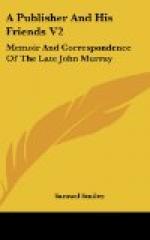The “Sartor Resartus” was not, however, lost. Two years after Carlyle’s visit to London, it came out, bit by bit, in Fraser’s Magazine. Through the influence of Emerson, it was issued, as a book, at Boston, in the United States, and Carlyle got some money for his production. It was eventually published in England, and, strange to say, has had the largest sale in the “People’s Edition of Carlyle’s Works.” Carlyle, himself, created the taste to appreciate “Sartor Resartus.”
CHAPTER XXX
MR. GLADSTONE AND OTHERS
In July 1838 Mr. W.E. Gladstone, then Tory member of Parliament for Newark-upon-Trent, wrote to Mr. Murray from 6 Carlton Gardens, informing him that he has written and thinks of publishing some papers on the subject of the relationship of the “Church and the State,” which would probably fill a moderate octavo volume, and that he would be glad to know if Mr. Murray would be inclined to see them. Mr. Murray saw the papers, and on August 9 he agreed with Mr. Gladstone to publish 750 or 1,000 copies of the work on “Church and State,” on half profits, the copyright to remain with the author after the first edition was sold. The work was immediately sent to press, and proofs were sent to Mr. Gladstone, about to embark for Holland. A note was received by Mr. Murray from the author (August 17, 1838):
“I write a line from Rotterdam to say that sea-sickness prevented my correcting the proofs on the passage.”
This was Mr. Gladstone’s first appearance in the character of an author, and the work proved remarkably successful, four editions being called for in the course of three years. It was reviewed by Macaulay in the Edinburgh for April 1839, and in the Quarterly by the Rev. W. Sewell in December. “Church Principles,” published in 1840, did not meet with equal success. Two years later we find a reference to the same subject.
Mr. W.E. Gladstone to John Murray.
13 CARLTON HOUSE TERRACE, April 6, 1842.
My DEAR SIR,
I thank you very much for your kindness in sending me the new number of the Quarterly. As yet I have only read a part of the article on the Church of England, which seems to be by a known hand, and to be full of very valuable research: I hope next to turn to Lord Mahon’s “Joan of Arc.”
Amidst the pressure of more urgent affairs, I have held no consultation with you regarding my books and the sale or no sale of them. As to the third edition of the “State in its Relations,” I should think the remaining copies had better be got rid of in whatever summary or ignominious mode you may deem best. They must be dead beyond recall. As to the others, I do not know whether the season of the year has at all revived the demand; and would suggest to you whether it would be well to advertise them a little. I do not think they find their way much into the second-hand shops.




